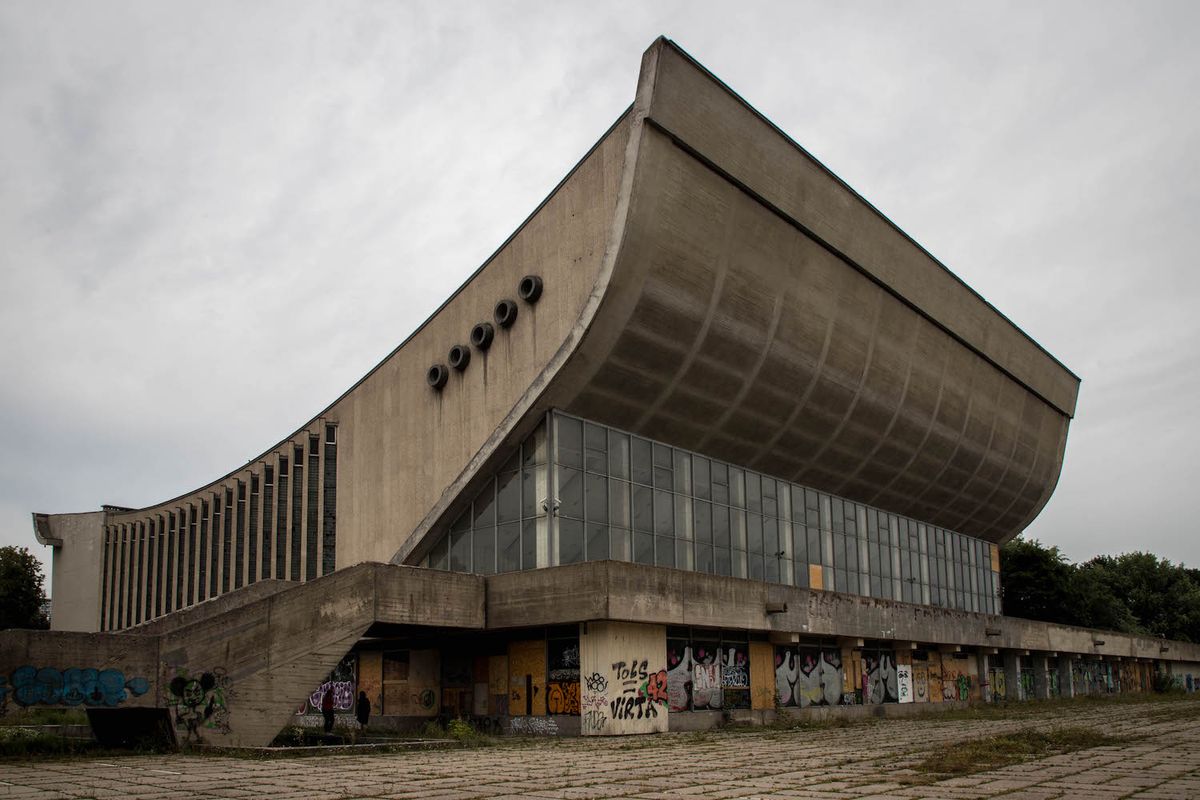About
Following the devastation wrought by World War II, the Soviet Union’s leaders issued a nation-wide directive to create new venues for entertainment and recreation. Countless new circuses and cinemas appeared throughout the USSR during the postwar decade, along with sporting facilities and the ubiquitous “Palaces of Culture.” These new cultural centers served both to distract Soviet soldiers and civilians from the horrors of the recent war, but acted also as places that might be used to instill a sense of shared pan-Soviet nationhood.
In post-war Vilnius, now Lithuania but at that time the capital of the Lithuanian Soviet Socialist Republic (1944 through 1990), the area on the northern bank of the Neris River was chosen as a new center for sporting activity. Žalgiris Stadium was built using a force of German prisoners of war, and opened in 1948. It was followed by a swimming pool and a skating rink.
The new developments caused controversy at the time. This had once been the location of Piramónt Cemetery, which, established in the late 15th century, was the oldest Jewish cemetery in Vilnius. Russian authorities had ordered the cemetery closed in 1831, and despite protests from the city’s Jewish population, the Soviets destroyed what was left in 1949 and 1950 as they laid the foundations for their new sporting facilities.
While most of these post-war sporting venues have themselves since been demolished, eagle-eyed visitors can still read the district’s history from its road signs: including Sporto (“Sports”) Street; Olimpiečių (“Olympians”) Street; and Raitininkų (“Riders”) Street. A more visible memento, however, is the imposing bulk of the now-abandoned Palace of Concerts and Sports.
Completed in 1971, the Vilnius Palace of Concerts and Sports (or “Sporto Rūmai,” “Sports Palace,” in Lithuanian) consisted of a large sports hall catering typically to sports such as volleyball and basketball, and with capacity for 4,400 spectators. In this post-Stalin era, Soviet architects were free from the artistic limitations of previous decades, and like many of its contemporary buildings, this sports hall was constructed in the Brutalist architectural style that had been popularized by Western nations.
Years later, the Palace of Concerts and Sports would serve as a venue for anti-Soviet sentiment too. In October 1988, the palace hosted the inaugural congress of Sąjūdis, a reformation movement which played a large role in Lithuania’s efforts to achieve independence from the Soviet Union. In January 1991, this former Soviet showpiece provided the venue for a public funeral of 13 Lithuanians who were killed by Soviet soldiers during the nation’s struggle for self-determination.
The Sports Palace remained in use after the collapse of the Soviet Union, though by the late 1990s, its arena had been converted to a complex of privately leased shopping and exhibition spaces. In 2004, it was closed for good after being deemed unsafe. By that time new, modern sports venues had begun to appear in Vilnius, and the cost of renovating the Soviet-era Palace of Concerts and Sports no longer seemed justified by its potential usefulness. Nevertheless, in July 2006 the building was added to a registry of architectural heritage sites, while the adjacent car park was converted into a memorial lawn, in respect of the Jewish cemetery that was destroyed to make room for it.
Related Tags
Know Before You Go
The Palace of Concerts and Sports is permanently closed, so don’t expect to be able to see inside—at least, no more than what you can glimpse through its large front windows. This unique work of Brutalist architecture is still well worth the visit however, and can be reached in an easy 15-minute walk from Vilnius’ Old Town area.
Published
October 4, 2019


























